Porcelain Insulator News
by Jack H. Tod
Reprinted from "INSULATORS - Crown Jewels of the Wire", December 1978, page 17
Dear Jack:
Recently I found two guy wire insulators with a marking that I
have not seen before. It has a large "O" stamped in light yellow ink on the
bottom of the insulator. The insulators are brown, 2-1/2" by 3-1/2", circular bottom
firing rest.
The marking could be the number "0" or the letter "O". If it is the
letter "O", could you tell me what company made it? Any other info would be
helpful.
Paul Colburn, N.I.A. #1348
Lake Worth, Fla.

- - - - - - - - -
Dear Paul:
Conventional
strain insulators such as this are nearly universally cataloged in the 500-520
number series, and this is the #502 size. The "0" would appear to have
nothing to do with the size. If it's a manufacturing company designation, no telling
which company. Ohio Brass Co. always used their regular O-B logo on strains, and
they don't use underglaze markings on poleline items as far as I know. Maybe one
of our readers can identify this marking for us.
Jack

Dear Mr. Tod:
My sister was at a flea market and got me some porcelain
insulators. Two of them are U-151 with a small metal rod (1/4" tall) leaded into
the insulator's top. One is a brown mo-name, and the other one is white with a CP marking as sketched.
Could you please identify what these insulators were
used for with this leaded top, and also the name of the manufacturer?
Dave Brown
Exeter, Cal.
- - - - - - - - -
The monogram-CP marking is Canadian Porcelain Co. I've seen these gadgets
before but never did know what their special use was. Maybe one of our Canadian
insulator buffs can help us out with the answer.
Jack
Dear Jack:
On page 33 of the September 1978 issue of CJ there is a photo of
Ronny Rofe leaning on a huge porcelain insulator. My father and I would like to
know if you have any info on it -- the U- number, manufacturer, vintage, value.
Could this insulator mould be a changed Pyrex CD-331?
Dave Kolbe
Manchester, Conn.
- - - - - - - - - -
Dear Dave:
I agree, it is huge -- about twice the size of any Pyrex design.
This is at least a 4-part (if not 5-part) cemented- together multipart, and
there are hundreds (if not over a thousand) of different multiparts as made by a
dozen manufacturers over an 80-year period. No one ever has made, or ever will
make, a style chart for all these large multis.
I wouldn't care to guess from
the magazine photo the manufacturer or its vintage. The only way to determine
the value of such insulators is to ask yourself what you'd pay to get one like
it, or what you'd take for one if you wanted to sell it. The range of answers
from one collector to another would vary all the way from zero to
"bundles".
There is no relation whatsoever to manufacturers of porcelain and glass insulators. Similarly, our newspaper doesn't have facilities for
brewing beer, and our brewery doesn't print newspapers. They are completely
different animals.
Jack

Enclosed is a sketch of an unusual (to me at least) porcelain insulator. [Marking is
LAPP/1930 plus Lapp monogram.] Is this piece a fairly common
insulator and, of course, do you know its value?
In general, I don't see too
many Lapp insulators around. Is this because they didn't make many, or are most
of them still in use?
Adolf Schimpf
Dover, N.J.
- - - - - - - - - -
Dear Adolf:
Your Lapp item is U-403A, and we list the consensus value on
these at $8 to $12 in the book, but with a notation that these prices prevail in
the west and might be a bit lower in the east where these were used and are
found.
I don't really know how common these and similar styles of cable
insulators are, but l'd say they are not common in collector circles. The ones
that have come our way have usually been from batches liberated by eastern
people who have some pull with utility company operations.
You are correct that Lapp pin types are not nearly as common as those from the other larger companies. Lapp always made pin types,
but their emphasis was on suspension insulators and all the many forms of
specialty HV porcelains. They even quit making unipart pin types in 1957 and
dropped multi-part pin types several years later.
Jack

Dear Jack:
... Secondly, in the 1925 edition of the Keystone Catalog (Coal
Edition), a mining catalog, I found an ad for The Cooke-Wilson Electrical Supply
Company -- addresses of Pittsburgh, Pa., Charleston, W. Va.; Athens, Ga.
Among
the many mining products (all electrical in nature) was "Insulators: All
kinds." There was also a photo of their Catalog #4, a thick book.
Apparently this 1925 cataloging jibes with the dates (1914-1932) you give for
American Porcelain Company being in business....
Matt Grayson
Roslyn, N.Y.
- - - - - - - - - -
Many thanks to Matt for shooting down another unattributed marking on pin
types. The sole specimen of a pin type with this marking is a U-98 mine
insulator found by Carl Lensce in 1973 at the old site of the defunct American
Porcelain Co. in East Liverpool, Ohio. (Jerry Turner take note: When this
specimen was found, my crystal ball said the initials in the marking stood for
"Electrical Supply Co.")
Jack
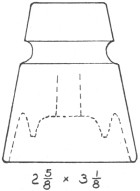
Lew Hohn (Rochester, NY) acquired this small foreign-style insulator from a
house in Victor, N.Y., and it was allegedly made at the Victor plant many years
ago. It's white, unmarked, no firing rest, normal foreign-size 1/2" pin
hole. (Locke did manufacture and catalog for export some small foreign styles
in the 1910-1920 period, and possibly later.)
Also found with this specimen was a
"mushroom" style Sim U-357 (smaller, 4-1/8" x 3-7/8"), and
it looks like a characteristic Locke product.
While vacationing in the midwest,
Lew saw some yellow insulators coming into a town and a few inside the town.
Through a lineman there, he managed to get one, and it's a Thomas U-668 -- the
"brightest yellow" Lew has ever seen on any insulator before.
Dear Jack:
I have a couple of questions about your First Edition of Porcelain
Insulators Guide Book.
In Appendix A (pages 188-197) you tabulate for each U-
number the Base TV and the "Confirmed Manufacturer". What I'd like to know is,
when you list a certain company under the confirmed manufacturer section, does this mean you have seen specimens marked with the name or trademark of
that
company, or is it that you had seen that shape (U- #) in that particular company's
catalog?
Also, if there is no confirmed manufacturer listed, does that
mean that specimens for that U- number are unmarked? I realize that many new
markings etc. have been discovered since, but I find this Appendix very helpful.
David Bethman
Bellingham, Wash.
- - - - - - - - - -
Dear David:
Glad you asked! Others have asked roughly the same question a
number of times, so here's the answer.
The original pricing system required a
tabulation of all the U- numbers with a Base TV (Trade Value), and then this
base value was adjusted upwards or downwards for rarer markings and colors,
insulator condition, etc. The column in this long tabulation headed "Confirmed
manufacturer" was just added as an informational bonus. It seemed a shame
not to advise collectors of what companies made some of the exotic shapes, since
many of these are not marked but were shown in catalogs.
The data for this
"Confirmed manufacturer" column in the tabulation came directly from
my master drawing sheets for each U- number. Generally it shows which company
cataloged that style. But the style chart includes several hundreds of shapes
which we've found in specimens but which never showed up in the catalogs that I
had seen to that time. A "Confirmed manufacturer" was shown for these if the specimens were marked;
otherwise, the column shows a blank space
for that style.
Everyone agrees with you that the tabulation was very useful,
especially to show the manufacturer of styles made by only one company and which
were never seen with a marking. We had a problem though, in that we had a small
flood of mail from collectors wishing to report that they had some ordinary
style with a marking not shown for that style in the tabulation. Trying to
tabulate all such data for ordinary styles would be an endless job and also of
questionable value in the end. I have never made any attempt to record all the
various companies that made given styles.
This tabulation was dropped from the
Second Edition of the book, primarily because a new pricing method merely
indicates prices for all the specific insulators worthy of mention. At the same
time, we naturally lost these "Confirmed manufacturer" data. Newer collectors
without the old book may now wonder who made styles such as the U-395 Mickey Mouse (Pittsburg), but at
least the aforementioned flow of mail about manufacturers of the common
styles abated.
Most of the worthwhile information on manufacturer of various
styles concerned the oddball items made by Pittsburg High Voltage, but we have
since learned that Pittsburg manufacturing methods were so uniquely different as
to allow us to identify their insulators in most cases by inspection alone. Most
collectors specializing in Pittsburg are well informed on this, and we have
widely published this information in this column and elsewhere on several
occasions,
Jack

Matt Grayson (Roslyn, NY) recently sent an advertisement clipped from
"Transrnission and Distribution" magazine which showed a complete line of wet
process, high-voltage insulators being marketed by Porcelain Products Co.,
Carey, Ohio. This company is a wholly owned subsidiary of the Clarken Company of
St. Louis, Mo., and the Carey plant is the old dry process porcelain plant
formerly owned by the A. B. Chance Company. Chance sold the Carey plant to
Clarken July 1, 1963.
To learn more about this development, I wrote to Mr. Rea
Guthridge, president of Porcelain Products Co., and his reply was, in part:
No, but yes! We do technically consider this a "new manufacturer" event
for pin types, since the actual ownership (corporate or company name) and
markings used are of dominant interest to us.
Mr. Guthridge was not specific as
to the use of two separate markings versus a combination marking, or as to the
type of marking method. I'm guessing that it means two different marking stamps,
and that these are underglaze types as were used in the Knoxville plant at that
time. If you collect specimens from all possible "manufacturers",
here's something new for you to chase after.
Jack
George Hanson (Columbia Falls, Mont.) sent us a clipping from the Montana
Rural Electric News which had some news on recent developments in high strength
porcelain insulators. The work is being sponsored by the Electric Power Research
Institute (EPRI) which is supported by over 500 of the nation's electric
utilities.
McGraw-Edison Company more than doubled the strength of standard
electrical porcelain by reducing the porosity to make the body material more
compact and by closely controlling the firing process.
Gould Inc. (Victor, NY)
more than doubled the strength of high alumina porcelains by altering the
composition and by improving the methods of mixing, forming and firing.
These
developments could lead to higher ratings for given designs or to higher safety
factors under current ratings. Manufacturers will soon begin procuring equipment
for making the improved insulators, and production should be under way within
two years.
(I believe these developments will probably have no major effects on
the visible appearance of ordinary pin types, since their sizes are mostly a
function of the voltage rating and not a function of their mechanical strength.
JT)

Emma Almeida (Shrewsbury, Mass.) reported more old wiring cleats and knobs she
has acquired, but one was a real eye opener -- the first report of a
"Cartwright Cleat" as shown here. The split name CARTW / RIGHT appears
on the other side between the wire holes.
As shown in my book Electrical Porcelain, this 1-6-91 patent is #444,317, Electric-wire insulating-cleat, J. S.
Potter and D. C. Cartwright, Boston, Mass. This is a one-piece cleat with
tapered holes for the conductors which are to be held in place with small wedges
in each hole.
This is a real museum classic, one of the earliest patents for a
porcelain wiring cleat. Even though it was necessary to string the wires
through the holes of all these cleats, this wasn't bad for a first try. A
succession of patents followed for cleats not requiring this tedious
installation process.
It is unthinkable that anyone would have used one of these
Cartwright cleats after the very practical two-piece cleats were on the market
only two years later. Unless you happen onto a standing building with the
original 1890's wiring or hit it lucky in the right dump, don't expect to ever
find an early rarity such as this.
Here are some more interesting items reported by Lew Hohn (Rochester, NY). He
found these insulator "advertiser" items at various flea markets in his area.
The
first one is this light tan pipe tray with the embossed (raised) markings for
Victor insulators, Inc. (1935-1953), Victor, N.Y. Tray and marking are both
drawn 1/2-size.
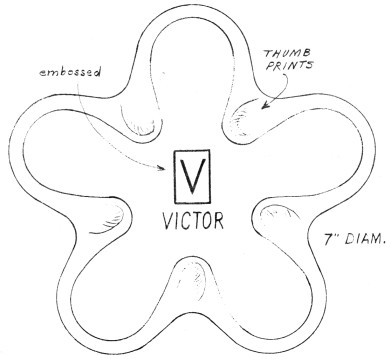
Here's another "advertiser" from Victor insulators, Inc. You probably got
your soup or ice cream served in this bowl and discovered the commemorative marking when you ate your way to the bottom of the bowl.
There's little doubt
that this company was one of the most prolific issuers of all sorts of
advertiser items. (The bowl is drawn 1/2-size.)
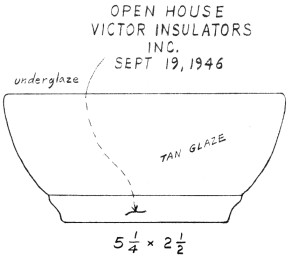
Here's another nice ashtray advertiser Lew found. Pinco's early term
"Horizon Glaze" (now standard as "Sky Glaze") probably dates
this item as late 1950's to early 1960's. The ashtray is drawn 1/2-size, the
marking nearly full size.
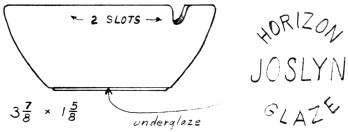
The following Ohio Brass Company item may look like some form of insulator,
but logic says it's an advertiser item, or part of one. The entire piece is
hollow with very thin walls and was made by the fill-and-pour casting method.
The side corrugations terminate at and blend into the flat triangular surface
with the trademark. Lew says it still has "cement" pieces sticking to
the inside, but I think this is probably a "plaster" used for filling
in event it was a paperweight or an attachment to some other item such as the
center of an ashtray.
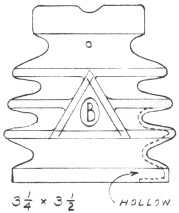
The drawing here is 1/2-size. The shallow top groove and the small thru-hole
below it are actually at right angles to the side with the trademark, but are
rotated in the drawing so they will show.
The marking is a simplified form of a trademark registered Aug 11, 1908
(#70,209) by Ohio Brass Co. in the same year they registered their O-B monogram
as used on their various products.

Years ago O-B used this trademark on packing cartons, letterheads, drawing
mastheads, etc. but never on insulator products themselves.
The embossed (raised elements) marking of this type would seem to date this
item early in the O-B insulator history, but this conflicts with the exterior
petticoats (fins) which came much later on, and also with the fact that the item
has a cobalt blue glaze. As a compromise guess then, I'd say this item stems
from the late 1920's to the 1930's. As insulator advertisers go, this one has to
rate as a "goody" in my estimation.
| 